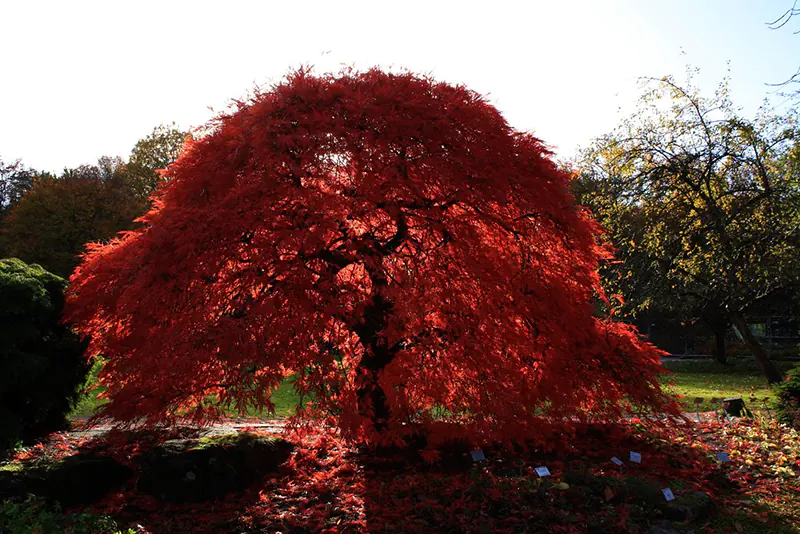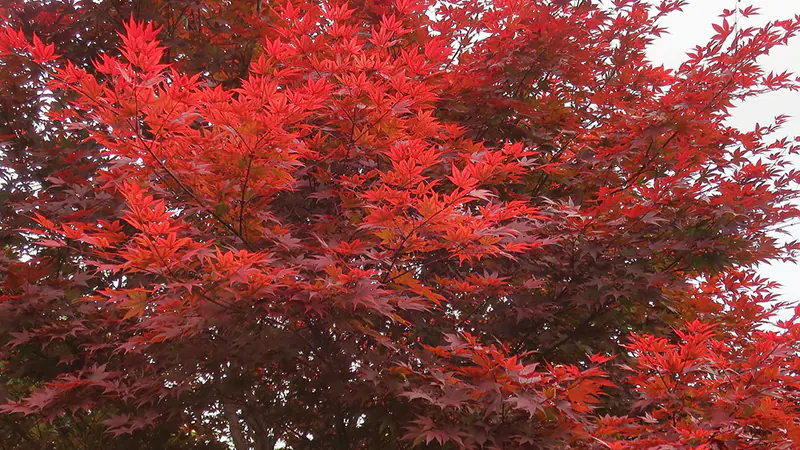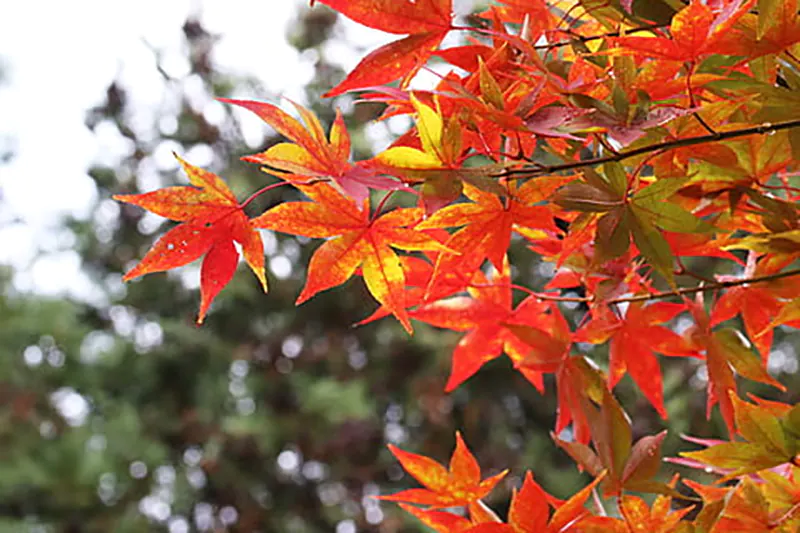Sherwood Flame Japanese Maple
The Sherwood flame Japanese maple is a great tree to grow, especially if you’re a newcomer to bonsai. The species takes well to most areas and has simple but routine requirements when caring for it.
In this article, we’ll walk you through all the steps of caring for this particular variation of the Japanese maple. We’ve got you covered from soil to sunlight requirements and various other aspects.
Image courtesy of Blondinrikard Fröberg
Here's what you'll find in our Sherwood Flame Japanese Maple bonsai species guide:
Here's what you'll find in our Sherwood Flame Japanese Maple bonsai species guide:
01
02
03
04
05
Quick Sherwood Flame Japanese Maple Bonsai Care Sheet
A quick reference table can be found below, providing a short yet accurate description of all the needs your Sherwood flame Japanese maple has.
Recommended soil | Akadama mixture. |
Watering | Once a day. |
Potting season | Every two years. |
Shaping and pruning season | Every two years. Best done during autumn. |
Light | Full sun, partial shade. |
Fertilizing | Solid organic fertilizer with low nitrogen content. |
Propagation methods | Seeds, air layering, and cuttings. Best results occur during august. |
Pests and diseases | Aphids, verticillium wilt, root rot, and leaf spots. |
How To Care For A Sherwood Flame Japanese Maple Bonsai
In this section, we’ll explain all the details about the Sherwood flame Japanese maple’s basic needs. From the best soil type to how often you should prune or water the tree.
Best Soil
While any regular bonsai soil mixture will work as long as it drains well, it’s not the best soil type available. This option does work well and will keep your bonsai alive. Additionally, this soil type is often more easily available.
If you’re looking for the best soil option, an akadama mixture with added lava rocks and pumice will help retain nutrients and moisture. This selection will affect how often you water your Sherwood flame maple and is important to keep in mind.
Watering
The Sherwood flame Japanese maple requires water at least once a day. Often, during warmer days, the tree will need watering more frequently. Soil types and temperature will affect how often you water the bonsai. We recommend plunging your finger into the soil and feeling for moisture before watering.
Repotting
Every two years, the roots of the Sherwood flame Japanese maple grow too large for its pot. As such, the tree needs to be removed and have its roots trimmed. During this procedure, you’ll want to inspect and cut away any infected roots carefully. Additionally, you’ll want to wash the pot to prevent root rot or other infections.
Shaping and Pruning
The small parts of your tree are prunable throughout the year. However, these pieces should only be cut every two years, lessening the stress placed on your bonsai. During autumn is the best time to cut larger branches, using a cut-paste afterward to prevent any infection.
Location and Sunlight
Keep your Sherwood flame Japanese maple in a well-aired environment that receives full sun and partial shade. The tree requires at least a few hours of sunlight each day, preferably during the morning. The summer afternoon sun can damage or affect the tree’s leaves and their coloring.
During winter, it’s best to shelter the tree from the cold. Temperatures close to freezing can harm the bonsai.
Fertilizing
A solid organic fertilizer is the best option available when growing a Sherwood Flame Japanese maple bonsai. Mix in a dose of liquid fertilizer once a week when watering your maple to add potency. These fertilizers should be low in nitrogen, an element that causes leaves to grow larger.
Propagation Methods
To grow a new Sherwood flame Japanese maple, you can use seeds, cuttings, or air layering. The new tree should be propagated during autumn.
Pests and Diseases
Aphids are the most annoying pests you’ll find clinging to your Sherwood flame Japanese maple. These tiny bugs often feed off the sap in the tree, weakening it and making it vulnerable to diseases and infections. Frequently misting your tree or using a regular store-bought insecticide will take care of any aphids on your bonsai.
Verticillium wilt, root rot, and leaf spots are common afflictions on a Sherwood Japanese maple bonsai. These can be managed by keeping your bonsai well-nourished and cutting away any afflicted areas.
Image courtesy of cultivar413
Considerations For Growing An Indoor Sherwood Flame Japanese Maple
Growing a Sherwood flame Japanese maple indoors is, at times, complicated. While the care is simple, you have a few considerations to consider, such as the placement and repotting periods.
Placement
Whine growing the Sherwood flame Japanese maple indoors; a morning sun-facing window is the best placement. The tree requires a few hours of sun every day and thrives best when kept from the afternoon sunlight.
Repotting
Every two years, the Sherwood flame maple requires repotting. As the tree grows its roots rapidly, this may become troublesome. Growing your bonsai in an apartment may cause a mess during this process.
Common Issues When Caring For A Sherwood Flame Japanese Maple Bonsai
There are a few concerns to be aware of when growing your Sherwood flame Japanese maple bonsai tree. Whether it’s infections and diseases or accidentally overwatering your tree, here’s what to keep in mind once you start growing this bonsai.
Infections and diseases
While verticillium wilt is the most common of infections, it’s not the only ailment to your bonsai. Your tree is prone to root rot, leaf spots, and afflictions. Fortunately, if you keep a close eye on your bonsai, you can catch and manage these conditions before they cause any serious harm.
Watering
Watering your bonsai can become a repetitive habit. As the Sherwood flame is a Japanese maple, it often requires watering once a day or more. We recommend you always check the soil’s moisture before watering, as watering purely on schedule can cause harm to the roots.
Sunlight exposure
While requiring full sun, the Sherwood flame Japanese maple has peculiar leaves. If kept in the summer afternoon sun, the foliage will turn green due to the heat. Managing sunlight exposure will help keep a rich set of leaves on your Sherwood flame maple.
FAQs About Sherwood Flame Japanese Maple Bonsai
Here are several of the most commonly asked questions regarding the Japanese maple species and its Sherwood flame variant. We explain which species is best for growing, its sunlight requirements, and why your tree may be dying or losing its leaves.
While many Japanese maple trees make for great bonsai, the best option is the beni hime, as it scars less and has small leaves. Additionally, this variant is a dwarf maple, ensuring it stays small during growth.
The Sherwood flame and other Japanese maples are best suited for full sun and partial shade. However, afternoon sunlight or warm temperatures can cause the leaves to turn green and potentially harm the leaves themselves.
Your Sherwood flame Japanese maple may be dying for several reasons. Overwatering and verticillium wilt are common causes of death among the species. Alternatively, your tree’s roots may be drying out from a lack of watering.
The Sherwood flame Japanese maple is a deciduous tree. It will lose its leaves if it enters hibernation during the winter season. In the right conditions, the tree may keep its leaves throughout the year, but this requires a lot of care.







